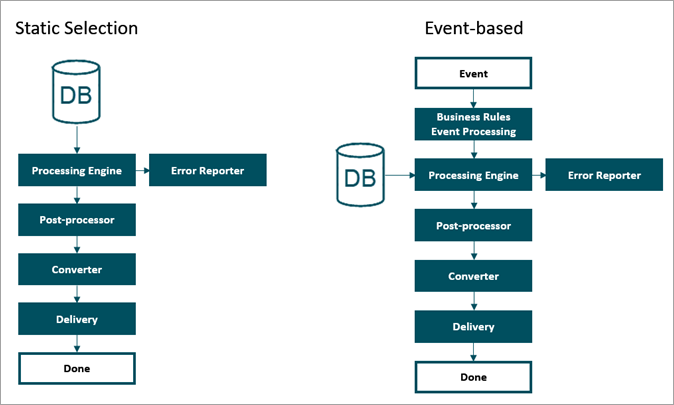The outbound integration endpoint (OIEP) functionality has been created to allow for easy extensions / customizations and can be understood as a plugin framework with interchangeable parts. The graphic below illustrates the structure for both a non-incremental endpoint based on a static selection and an event-based endpoint. The colored boxes represent the interchangeable parts, which are described below.
As the data source, an OIEP can either use a static selection of hierarchy root nodes, or events tied to selected objects in STEP. The delivery options and export formats are the same regardless of the data source selected. By default, this list will be the same as for the Export Manager.

Business Rules Event Processing
For event-based endpoints, business conditions can be used to filter events and business actions can be used to generate new events based on others. For more information, refer to the 'Event Filter' and 'Generate Event' sections of the OIEP - Event-Based - Event Triggering Definitions Tab topic.
Processing Engine / Converter
The processing engine is responsible for performing the actual data export based either on events or a static selection. STEP Exporter is the only available option with the core functionality, and is also the standard functionality used for manual exports. If a special format not supported in the standard STEP Exporter is required, the processing engine can be replaced via an extension. Most often, however, creating a converter for the STEP Exporter is sufficient for such cases. This approach also has the benefit that the same converter is available for manual exports. For more information, refer to the OIEP - Event Based - Configure Endpoint topic or the OIEP - Select Objects - Configure Endpoint topic.
Error Handling & Reporting
STEP includes a single Send Error Report option to report errors. An email can be sent to specified addresses if errors and/or warning occur when files or messages are handled by the processing engine. For more information, refer to the 'Error Handling & Reporting' section of the OIEP - Configuration Section topic.
Post-Processor
A post-processor has access to the file delivered by the processing engine and can manipulate it and/or split it into multiple files. STEP includes two post-processors, both used for manipulating files output by the processing engine with cross context information. For more information, refer to the OIEP - Event-Based - Output Templates Section topic and the OIEP - Select Objects - Output Templates Section topic.
Delivery
A delivery method has access to the file(s) output from the processing engine / post-processor. Additional delivery options can be added with the delivery plugin extension. For more information, refer to the OIEP - Delivery Method Section topic.